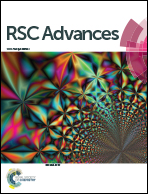Promoting the photocatalytic activity of Bi4Ti3O12 microspheres by incorporating iron†
Abstract
Small amounts of Fe(NO3)3 were added to the synthesis mixture prior to the hydrothermal synthesis of Bi4Ti3O12 microspheres. The physicochemical properties of the resulting materials were changed accordingly. The photocatalytic activities of several samples were studied through the photocatalytic degradation of organic pollutants. The samples with a theoretical Fe atomic percentage of 5.9% showed the highest photocatalytic activity among these samples. The main active species in photocatalytic degradation was demonstrated by radical capturing experiments as h+. The introduction of a suitable amount of Fe to the photocatalyst can facilitate the separation of electron–hole pairs generated upon light irradiation, inhibit their recombination efficiently, and prominently expand the light absorption region, thus leading to higher photocatalytic activity.



 Please wait while we load your content...
Please wait while we load your content...